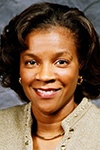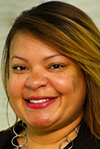
Meeting Diversity Challenges, Both in Hiring and Lending

Laura Lang
If you think about the numbers, things just don’t add up.
The 2020 census found the White (non-Hispanic) population in the United States has dropped 8.6% since 2010, making the current mix something along the lines of 57.8% White, 18.7% Hispanic, 12.4% Black, and 6% Asian American. The same data show our country is becoming even more diverse, with increases in Hispanic, Black, Asian-American, and multiracial populations.
However, the mortgage industry is still overwhelmingly White (72%), notes the Joint Center for Housing Studies at Harvard and the Brookings Institution. Hispanic or Latino, Blacks, and Asian Americans represent just 9.1%, 7.5%, and 9.4%, respectively, of the mortgage industry workforce.
Perhaps more telling, from 2000 to 2019, the housing industry workforce increased by 66%, yet the representation of Hispanics and Blacks only increased by 5% and 1.98%, respectively. The numbers are even more stark at the top of the industry, with the number of Hispanic CEOs in the housing industry increasing by only 4.15% and Black CEO representation rising by only 0.34%.
If that current rate of change continues, it will take 114 years before the diversity of the housing industry reflects the diversity of our overall population, according to a Fannie Mae study – and that’s problematic.
Homeownership numbers aren’t much better. Using 2019 data from the American Community Survey, the White homeownership rate is 30% higher than for Blacks, and White households are 71% more likely to own their homes than Black households.
So, if you’re not hiring, or creating homeownership for minorities, you’ll find the road ahead to be tougher. In other words, diversification, both in the workforce and in lending, is a business imperative now and in the future, and it’s one the Mortgage Bankers Association has embraced wholeheartedly for more than a decade.
Expanding Its Message
In 2012, MBA formed a member-led Diversity, Equity, and Inclusion Advisory Committee, a Board-appointed body, to provide leadership and guidance on increasing diversity in leadership, workforce, and suppliers.

Getting the initiative off the ground included launching a diversity and inclusion conference. “Over time, we realized that while we were attracting many industry leaders, we kept talking to the same people,” says Lisa Haynes, SVP, Chief Financial Officer and Chief Diversity and Inclusion Officer at MBA. “So, we shifted from one conference focused on DEI and we started putting our DEI message into every major conference.”
That spurred two other DEI efforts:
- MBA launched its Path to Diversity (P2D) scholarship, which gives recipients a voucher to cover course registration fees, up to a maximum of $2,000, for popular MBA Education courses and designation programs, as well as select conferences where attendees can obtain Continuing Professional Education (CPE), Continuing Legal Education (CLE), or Society of Human Resources Management (SHRM) credits. This education opportunity enables employees from diverse backgrounds to advance their professional growth and career development.
- Marcia Davies, MBA’s COO, also founded mPower, the largest networking organization for women in real estate finance. “mPower was pivotal in bringing more women into the fold,” says Haynes, “but race was still another issue we needed to focus on.”
Making Diversity ‘Business as Usual’
Diversifying the workforce of the housing finance industry – in terms of race, income, gender, and sexual orientation/sexual identity – is a monumental task.
“People generally understood the need for change but weren’t sure where to find this ‘new pool of diverse candidates.’ Of course, there is no pool; we knew we had to create the pool,” says Haynes.
People were starting to listen and talk about equality when the “dam broke” in 2020 with the murder of George Floyd in Minneapolis. “The Floyd murder caught people’s attention, and they started to realize how much the landscape is changing in terms of the majority and minorities in this country and how we talk about racial equality,” says Haynes. “Racial tensions strengthened the case that if you’re trying to sell homes to Black and Brown people, it’s really important to have Black and Brown people in that process.”
Susan Stewart, 2021 MBA Chair, made diversity a priority for members, introducing a policy initiative, Building Generational Wealth Through Homeownership, aimed at providing industry leadership and direction for reducing the racial homeownership gap; developing and supporting policies that support sustainable homeownership for communities of color; and promoting fair, equitable, and responsible lending for minority borrowers.
Through advocacy, partnerships, and connections within the industry, MBA’s initiative will increase homeownership opportunities for minority borrowers, expand homeownership readiness to future borrowers, and assist current homeowners with maintaining and maximizing the benefits of homeownership.
“Homeownership is often the largest source of intergenerational wealth for families. MBA’s new policy initiative serves as a perfect foundation to level the playing field,” Stewart said at the time of the initiative’s launch. “The mortgage industry has a responsibility to promote minority homeownership by partnering with key stakeholders to remove barriers and support financial education and counseling, with a goal to close the racial homeownership gap and increase generational wealth among minority households.”
Her successor, current MBA Chair Kristy Fercho, built off of that platform with the Home for All Pledge, which focuses on minority homeownership, affordable housing, and diversifying the industry.
Today, every major MBA conference includes a DEI component – including panels that have diverse representation, sessions to answer questions on how to recruit minorities into your business, how DEI impacts the bottom line, or why you’ll need to have Black and Brown loan officers talking to borrowers to boost your minority business.
Intentionally incorporating DEI into programming isn’t just for MBA conferences – you will also see it in webinars and training.
An award-winning, three-part virtual series, Voices: Courageous Conversations with Women of Color, held in 2020, explored the experience of being a woman of color in real estate finance. During this series, MBA members heard from a dynamic lineup of female industry leaders as they shared their personal journeys and discussed solutions to bridge the gap through allyship, mentorship, and sponsorship.
In June and July, Voices: Courageous Conversations with Men held two sessions. The first session focused on men of color and their experiences, challenges, and successes in their careers. The second session addressed the issue of men as allies and explored the experience of LGBTQ+ men in our industry and how men can be allies to all colleagues.
“We’ve now integrated DEI into everything we do,” says Haynes.

Diversifying Isn’t a ‘One-Size-Fits-All’ Proposition
Even when lenders agree on the need for diversity, they’re not always sure where to start. According to Amber Lawrence, MBA Associate Vice President–Diversity, Equity, and Inclusion, that’s because there’s no single “right” way to develop a DEI program or an “exact” number of resources needed to make it successful.
The best programs embrace many ideas and move forward with those that work best. Some of the tactics that are working well include:
- Forming partnerships – Working with outside partners like national organizations that represent minority mortgage professionals and HUD-approved housing counseling agencies gives you access to new ideas and people who can help you gain access to underserved communities, and ultimately boost your bottom line. Partners can help with down payment assistance programs, consumer education, financial literacy, and more. You might get referrals for better-prepared borrowers, save time and effort for your LOs, or receive good word-of-mouth advertising in underserved communities.
- Involving executives – Having C-Suite executives involved with your DEI efforts sends a clear message of the importance your organization places on DEI. It also further ensures that your DEI goals will align with broader corporate goals.
- Recruiting, retaining, mentoring, and promoting – An effective diversity hiring program doesn’t end with the hiring of a few people. You’ll need to take a “pipeline” approach to continually hiring candidates, mentoring them as their careers advance, and promoting them as they reach competence milestones.
- Ongoing education – The word “diversity” can carry a stigma and the changing demographics of the country aren’t necessarily common knowledge to customer-facing employees. Increased understanding within the workforce means easier adoption of the organizational shifts and market strategies you’ll be making to stay competitive, and it ensures everyone is on the same page.
Pooling Efforts and Reaching into Colleges and Universities
There’s no doubt MBA and its partners have raised visibility on DEI in housing finance and created momentum over the past 10 years. But there are still some challenges: “As you approach your organizational diversity, it’s important to know that a handful of minority hires does not make a robust DEI program,” says Lawrence.
Employees need to feel that their point of view is heard and valued, and that they have a chance to make an impact on the company. Tactics such as ERGs, mentorship programs, and contact with C-Suite executives are low-resource methods to increase the all-important “I” in DEI.
“A stumbling block has been where to spend money and which partnerships to grow,” notes Lawrence. One program gaining traction will be a certification program launching later this year targeting women, women of color, and people of color attending colleges with diverse populations.
MBA works with the National Association of Minority Mortgage Bankers of America (NAMMBA), a national trade association dedicated to the enrichment and betterment of women and minorities who work in the real estate finance industry. Says Lawrence: “They put on dynamic programming at the state and local level, and will be putting on an event to expose students to careers in mortgage finance and people of color and positions of influence.”
MBA also works with Fannie Mae’s Future Housing Leaders program, HomeFree-USA, the Center for Financial Advancement (CFA), and others, to introduce minority students to the housing finance industry.
“What’s important is not only getting students of color into the industry but supporting them while they’re there, and helping them progress their career through to leadership,” Lawrence says, pointing to a new MBA program called the Developing Leaders Mentoring Program, powered by Engage Mentoring.
“This unique development opportunity allows participants to grow their leadership capacity by serving as both mentor and mentee on topics of their choosing and receive career advice,” says Lawrence.
Many other initiatives are also underway, she says.
The Work Has Only Just Begun
Both Haynes and Lawrence are passionate about increasing access for minority students and homeowners. “I am motivated by the fact that the work we’re doing is going to help our members become better at what they do,” says Haynes. “I think, holistically, we are all organizations that are better when we capitalize on our diversity, whether that’s diversity in terms of gender, race, thought, or whatever.”
“One of the things that I would say about our industry is the more inclusive we are, the better we are – that applies to commercial/multifamily and it applies to residential. The more we are focused on inclusivity both in employment and in housing, and in business, the better we’re going to be as an industry,” she says.
Black homeownership rates are as low as they were when the Fair Housing Act was passed. “We’re trying to turn the tide on that,” says Haynes. “We all want a job that will let us provide a financial future for our children and family. For many, this begins with access to affordable housing and foundational financial education that can lead to homeownership. In turn, homeownership helps build wealth that can be passed from generation to generation,” she adds.
The bottom line: In our industry, diversity and inclusion are not “feel-good” initiatives that happen off to the side of your company’s ledger – not when 44% of the largest generation of potential homebuyers, millennials, are the future of your business.
If you’re not looking ahead and getting ready for the workforce you’ll need to land the customers of the future, the numbers may catch up to you. “We don’t want our members to be Blockbuster that never saw Netflix coming,” says Haynes.
For more information on MBA’s Diversity, Equity, and Inclusion (DEI) commitment, visit the DEI Resource Center here.
Laura Lang is an industry writer currently based in Fresno, Calif. She can be reached at lauralhaverty@gmail.com.
